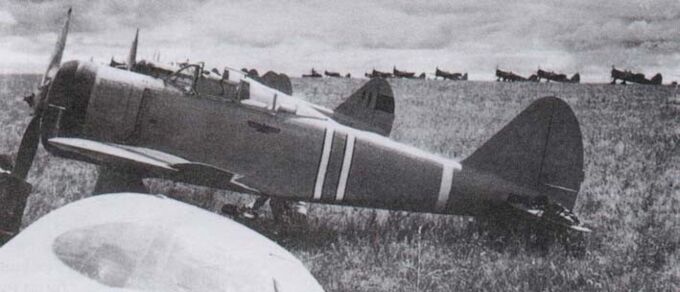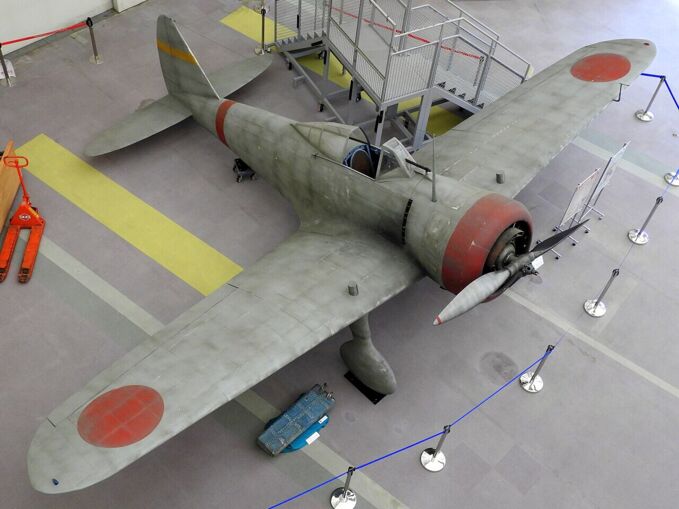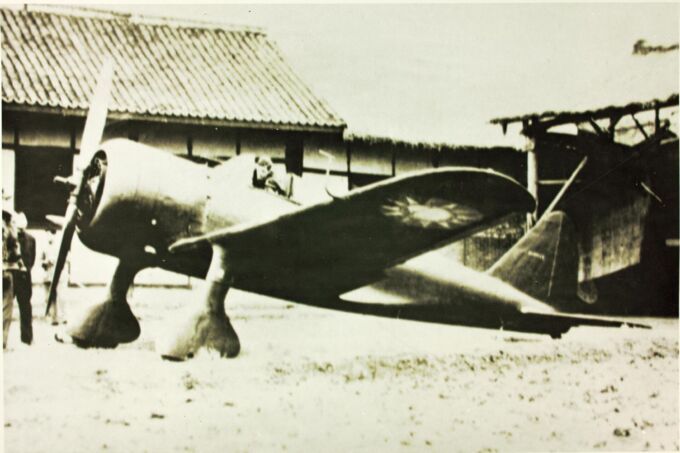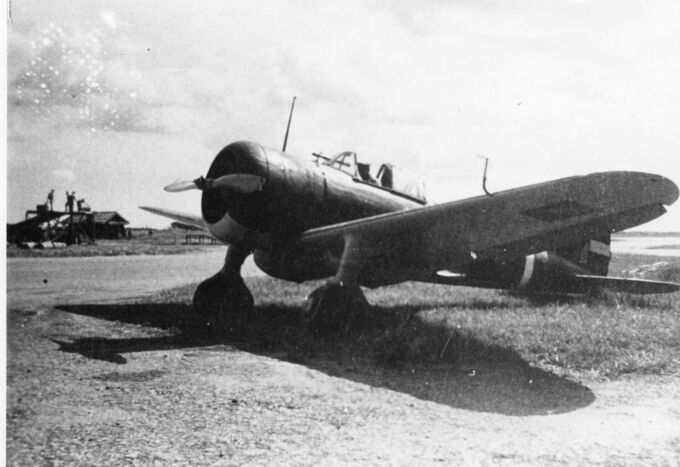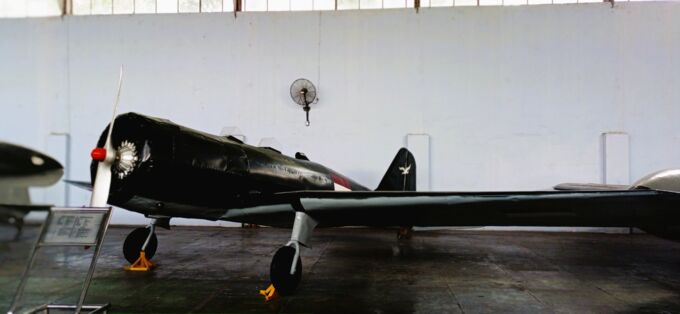The Nakajima Ki-27 (九七式戦闘機, Kyūnana-shiki sentōki), also known as Type 97 Fighter, was a monoplane fighter used by the Imperial Japanese Army Air Service up until 1940, which was developed to replace the Kawasaki Ki-10, the Army’s last biplane fighter. Its Allied reporting name was “Nate”, although it was called “Abdul” in the China Burma India theater by many post-war sources.
Design, Development and Variants:
In 1935, the Imperial Japanese Army Air Force initiated a competition to develop a new monoplane fighter to replace the aging Kawasaki Ki-10 biplane. Nakajima’s submission, the Ki-27, was designed by Yasushi Koyama and drew inspiration from the earlier Ki-11 prototype. The Ki-27 featured a low-wing monoplane design with an all-metal construction, fixed landing gear, and was powered by a Nakajima Ha-1b radial engine. Emphasizing maneuverability, the aircraft had a low wing loading, allowing for exceptional agility in dogfights. Armament consisted of two 7.7 mm (0.303 in) Type 89 machine guns on early models, and one 12.7 mm (0.5 in) Ho-103 machine gun and one 7.7 mm (0.303 in) machine gun on later models.
The Ki-27 first flew on October 15, 1936, and entered service in 1937 as the Army Type 97 Fighter. Despite being slower and having a poorer climb rate compared to its competitors, the Ki-27 was selected for its superior turning ability. A total of 3,368 units were built by Nakajima, Tachikawa Aircraft Company, and Manshūkoku Hikōki Seizo KK until production ceased in 1942.
Variants:
- Nakajima Army Type 97 Fighter: Long Army designation for the Ki-27.
- Nakajima Type PE: Private-venture experimental aircraft with Nakajima Ha1a engine.
- Nakajima Ki-27: Prototype version with armament in response to IJAAF specs, two aircraft built.
- Nakajima Ki-27-Kai Prototype: Pre-production units with armament and heavier Nakajima Ha1b engine, 10 aircraft built.
- Ki-27a: First production version with approximately 565 aircraft built.
- Ki-27a-Kai: Trainer version converted from existing production. Approximately 150 aircraft converted.
- Ki-27b (Army Type 97b Fighter): Improved canopy, oil cooler and provision for 4 × 25 kg (55 lb) bombs or fuel tanks under the wings. 1492 aircraft built, including 50 by Tachikawa Aircraft Company Ltd.
- Ki-27b-Kai: Trainer version converted from existing production. Approximately 225 aircraft converted.
- Nakajima Ki-27-Kai: Experimental lightened version developed as an interim solution when Ki-43 development was delayed with a top speed of 475 km/h (295 mph). Two aircraft built.
- Mansyū Ki-79: Trainer version, built by Manshūkoku Hikōki Seizo KK with a 510 hp Hitachi Ha.13a-I or Ha.13a-III engine. A total of 1329 aircraft built in four sub-versions: The single seat Ki-79a (Ha.13a-I) and Ki-79c (Ha.13a-III) and the two-seat Ki-79b (Ha.13a-I) and Ki-79d (Ha.13a-III).
- Mansyū Army Type 2 Advanced Trainer: Long Army designation for the Mansyū Ki-79.
- B.Kh.12: (Thai: บ.ข.๑๒) Royal Thai Air Force designation for the Ki-27b.
Operational History:
The Ki-27 was first deployed in March 1938 during the Second Sino-Japanese War, quickly establishing air superiority over Chinese forces. Its agility made it formidable against contemporaries like the Soviet Polikarpov I-15 and early I-16 fighters during the Battles of Khalkhin Gol. Japanese pilots, benefiting from better training, gained aerial superiority despite the Ki-27's lack of armor and self-sealing fuel tanks. As adversaries introduced faster and better-armed aircraft, however, the Ki-27's limitations became evident. The improved Soviet I-16s with 20mm cannons and better armor nullified the Ki-27's advantages. The Soviet Air Forces adopted new tactics, flying in large formations and utilizing hit-and-run attacks, which further challenged the Ki-27's effectiveness.
At the outbreak of the Pacific War in December 1941, the Ki-27 was still the main frontline fighter of the Imperial Japanese Army Air Force. It played a significant role in the early Japanese offensives across Southeast Asia, where it initially saw success due to the element of surprise and the generally outdated state of many Allied air forces in the region.
In Malaya and Singapore, the Ki-27 fought for air superiority and took part in bomber escort missions, often engaging in dogfights with Brewster F2A Buffaloes and Hawker Hurricanes of the Royal Air Force. Its nimble handling and tight turning radius gave it an advantage in close-quarters combat, and Japanese pilots, who had extensive pre-war training and combat experience, exploited this to the fullest. A similar approach was taken during the invasions of Burma and the Dutch East Indies.
However, as the war progressed into 1942 and beyond, the Ki-27 began to show its age. Its lack of armor, low top speed, and light armament (typically just two 7.7 mm machine guns) left it increasingly vulnerable against new Allied fighters. Aircraft like the Curtiss P-40 Warhawk, Bell P-39 Airacobra, and the Republic P-47 Thunderbolt could outclimb, outgun, and outrun the Ki-27 with ease. At this point, the Nakajima Ki-43 Hayabusa began replacing the Ki-27 in frontline units. However, due to production limitations and logistics, it continued to serve in secondary roles and in areas where newer aircraft were not yet available.
In the later years of the war, some Ki-27s were transferred to training squadrons, while others were used for home defense or interception duties. As Japan’s situation deteriorated, Ki-27s and Ki-79s were pressed into service for last-ditch suicide missions, with pilots using them in kamikaze attacks, although their light construction limited their destructive potential.
The Ki-27 was exported to Manchukuo and Thailand, seeing combat with both nations. In Thai service, Ki-27s reportedly damaged two North American P-51 Mustangs and shot down one Lockheed P-38 Lightning and one P-51 Mustang. In addition, Type 97s that ended the war overseas were seized and used by both the Republic of China and the People’s Liberation Army. After the war, a few Ki-27s and Ki-79s were used during the Indonesian National Revolution after being seized from the Japanese.



